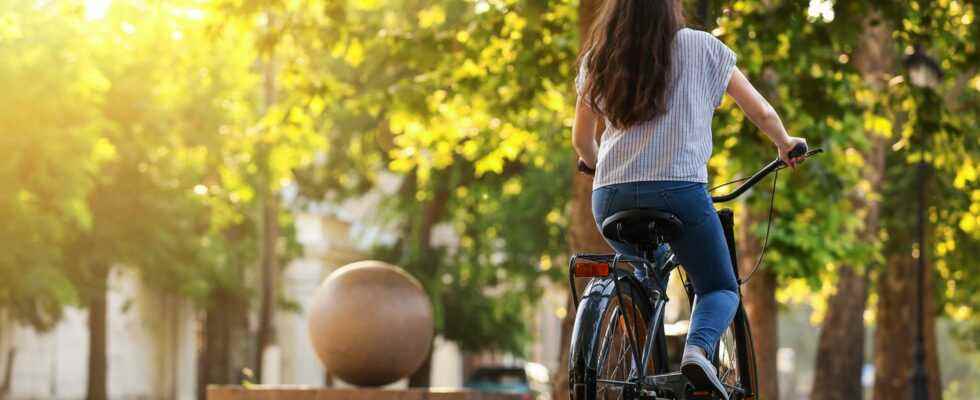To go biking
Why you should start pedaling now
© Pixel Shot / Adobe Stock
Cycling is back in vogue again. Pedaling has a lot to offer…
The good thing about cycling is that it makes you fit, doesn’t have to be expensive, and you move in the fresh air. And it’s getting warmer every day: wonderful! Good reasons to get the bike ready again (lights? brakes? rust?) and start pedaling. A couple facts and tips on the subject? Here you go!
Corona profiteer
The bike is a clear pandemic winner: According to the Ministry of Transport, manufacturers sold ten percent more in 2021 – a total of 2.37 million units. 25 percent of Germans rode their bikes more often in 2020 than in the previous year. According to the Bicycle Monitor 2021, 77 percent cycle, 31 percent get on their bikes at least once a week, every tenth even daily. After all, it’s pretty contagious.
Tip: Try a different model for the fun factor to stay motivated. Particularly in demand at the moment: pedelecs, gravel bikes (a combination of racing bike and mountain bike) and cargo bikes.
what it does physically
A lot! It’s easy on the joints effectively trains the cardiovascular system, stabilizes blood pressure and stimulates the immune system. In addition, you burn a lot of calories, tighten your legs and buttocks and strengthen your back muscles. Perfect for really getting going.
However, the truth is also: It takes a certain regularity – It should be easy cycling three times a week for 30 minutes, to achieve the above effects. If you want more, you can ride your bike to work, for example, and make the whole thing a little sportier. This is how it works: cycle for five to ten minutes, then alternately pedal for 40 seconds intensively and 20 seconds relaxed. Repeat these short intervals ten times. Then drive out easily.
Tip: When we sit in the saddle, the legs and buttocks work the most. Additional muscle training ensures that we also strengthen and tone the other parts of the body – which is why we like to pimp cycling with full-body exercises such as push-ups, squats and planks, which can be incorporated into the route. Just hold or repeat until your muscles burn.
It doesn’t get any greener
As a zero-emission vehicle, cycling is one of the most environmentally friendly modes of transportation. Or expressed in figures: For a 16-kilometer journey to work, we save five kilos of CO2 if we pedal instead of sitting behind the wheel. According to the Federal Statistical Office, however, only one or one in ten commuters has done so so far, 13 percent take the bus and train, 68 percent the car. Another argument for switching? US researchers have shown that the bike makes us happiest when we commute.
Gender Bike Gap?
There is actually, at least a little, in things equal rights Things are not going quite smoothly here either: Four percent fewer women than men regularly get on their bikes in Germany, worldwide it is 6.7 percent. Catcalling (i.e. suggestive calling, whistling…) and fear in the dark apparently still deter many a woman. Just like the infrastructure: If you look at bike-friendly countries like Denmark, women are in the lead – so road safety also seems to play a role.
in the competitive sport A lot is already happening, but there is still room for improvement. “Although women are on the rise, they are still less likely to venture into endurance competitions, largely because they are doing it alone,” writes Hannah Ross in her feminist book Revolutions Euro, 320 p., Mairisch).
Tip: When it comes to female empowerment, the women’s networks in the Allgemeine Deutsche Fahrrad-Club e. V. (ADFC; e.g. bw.adfc.de), the “La Dolce Velo Women’s Rides”, which offer tours for women in Berlin and the surrounding area (velocity.berlin), the queer-feminist bike demos “Purple Ride ” (facebook.com/purplerideberlin) or the Women’s Bike Camps (womensbikecamp.com).
Why, surely
Motorists must keep a distance of one and a half meters when overtaking a bicycle in the city, outside it is even two meters: This is how German traffic law regulates it. The reality is often different … But at least the municipalities are doing something to ensure more safety – and thus more driving fun: In many places there are already new cycle lanes or roads, for example in Berlin or Hamburg, Freiburg or Heidelberg, and the expansion continues. Suggestions for even more pro-bike commitment come from abroad: Why not stipulate a speed limit of 30 in our country, like in Paris, or secure the bike lanes with curbs, like in Denmark?
Tip: In order to be safe on the road, it is best to always wear a helmet and without headphones in the saddle and keep your hands on the handlebars. You can’t say that often enough because it reduces the number of serious accidents. If you want your hair to look nice in the office, you can switch to an airbag around your neck.
